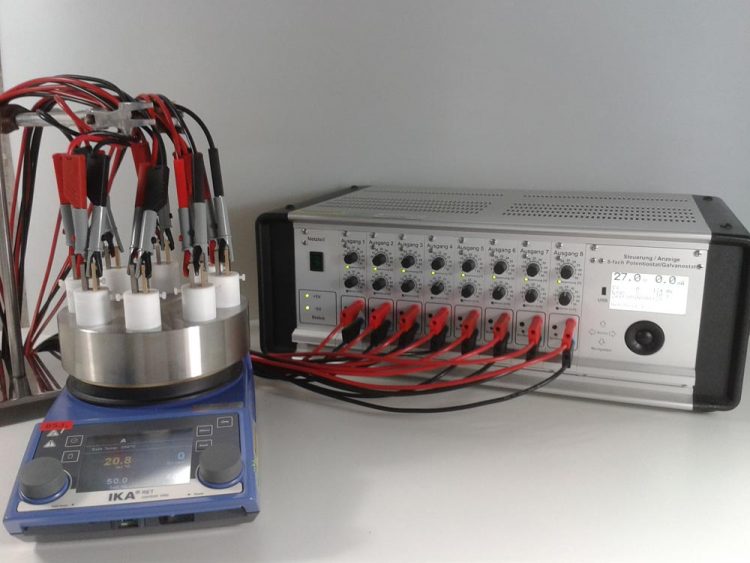Research on the sustainable conversion of lignin into valuable chemical compounds is attracting further funding

Experimental setup for determining optimal reaction conditions (screening) photo/©: Waldvogel group, JGU
The Electrosynthesis group at Johannes Gutenberg University Mainz (JGU) is further expanding its methods for the production of sustainable chemicals from lignin. The research lab, headed by Professor Siegfried Waldvogel at the JGU Institute of Organic Chemistry, is coordinating a partnership consortium of businesses and institutes of higher education.
The SElectiveLI project was set up by the EU and an industrial consortium and is being funded through the Bio-based Industries Joint Undertaking (BBI JU) Public-Private Partnership. Over the next three years, EUR 2.9 million will be provided to reach an ambitious goal: Working together with numerous European partners in this project, the aim of Waldvogel's team is to show how lignosulfonate, a waste product of the paper and pulp industry, can be used to produce valuable 'green' compounds. To implement this complex process, it will first be necessary to carry out a feasibility study on laboratory scale. The project was launched on May 1st, 2019.
Electrochemistry applies electric current to promote chemical reactions directly. This strategy avoids the use of valuable and limited resources for reagents and catalysts that would otherwise be necessary to enable such reactions. A further advantage is the fact that it is also possible to use excess electric energy for electrochemical purposes generated from renewable sources.
Lignin as a source of chemicals for the production of carbon-neutral plastics
In SElectiveLI, electrochemistry serves in various applications, including the conversion of lignin into valuable chemicals. Paper production generates a considerable amount of the bio-adhesive lignin as a by-product: 50 million tons per year. Up to date, the challenging chemical properties of this unique bio-derived structure leads to its primary use as combustible material to generate thermal energy.
However, lignin is packed with basic compounds that are envisaged to be used in the manufacture of carbon-neutral plastics, adhesives, vanillin, and other major commodity chemicals. Another aim of the project is to facilitate the complex process required for the separation of the target compounds from the reaction mixture obtained from the electrochemical process.
“We hope to develop an inexpensive way of producing green chemicals and, if possible, make the use bisphenol A obsolete in the future,” stated Professor Siegfried Waldvogel.
“This also involves investigating processes that make the use of renewable energy as a power source for electrochemistry feasible. In addition, we will exploit a source of renewable material that will not be competing with food production.”
Furthermore, the researchers want to demonstrate the possibility to reduce possible negative environmental impacts resulting from the industrial process. Rendering these processes as environmentally friendly as possible, the extraction of valuable compounds is improved by reducing the water consumption and by using non-toxic materials to facilitate reactions.
The team led by Professor Siegfried Waldvogel already received EU funding in 2018 for a project designed to explore the potential for the utilization of alternative lignin product flows. In the case of the more recent project, the group is part of an international consortium that envisages the construction of an electrochemical plant to investigate the opportunities for the commercial exploitation of chemical compounds derived from lignosulfonates.
Images:
http://www.uni-mainz.de/bilder_presse/09_org_chemie_eu_selectiveli_01.jpg
Experimental setup for determining optimal reaction conditions (screening)
photo/©: Waldvogel group, JGU
http://www.uni-mainz.de/bilder_presse/09_org_chemie_eu_selectiveli_02.jpg
A researcher working on an electrochemical flow reactor
photo/©: Alexander Sell
Related links:
https://www.aksw.uni-mainz.de/ – Waldvogel group at the JGU Institute of Organic Chemistry
Read more:
http://www.uni-mainz.de/presse/aktuell/6739_ENG_HTML.php – press release “EU funding to promote the utilization of lignin” (24 Oct. 2018)
http://www.uni-mainz.de/presse/aktuell/6017_ENG_HTML.php – press release “Protection for the ozone layer: sugar molecules bind harmful CFCs” (10 Sept. 2018)
Professor Dr. Siegfried R. Waldvogel
Institute of Organic Chemistry
Johannes Gutenberg University Mainz
55099 Mainz, GERMANY
phone +49 6131 39-26069
fax +49 6131 39-26777
e-mail: waldvogel@uni-mainz.de
https://www.aksw.uni-mainz.de/prof-dr-s-r-waldvogel/
Dr. Jesco Panther
Institute of Organic Chemistry
Johannes Gutenberg University Mainz
55099 Mainz, GERMANY
phone +49 6131 39-20466
fax +49 6131 39-26777
e-mail: jpanther@uni-mainz.de
Media Contact
More Information:
http://www.uni-mainz.de/All latest news from the category: Life Sciences and Chemistry
Articles and reports from the Life Sciences and chemistry area deal with applied and basic research into modern biology, chemistry and human medicine.
Valuable information can be found on a range of life sciences fields including bacteriology, biochemistry, bionics, bioinformatics, biophysics, biotechnology, genetics, geobotany, human biology, marine biology, microbiology, molecular biology, cellular biology, zoology, bioinorganic chemistry, microchemistry and environmental chemistry.
Newest articles

NASA: Mystery of life’s handedness deepens
The mystery of why life uses molecules with specific orientations has deepened with a NASA-funded discovery that RNA — a key molecule thought to have potentially held the instructions for…

What are the effects of historic lithium mining on water quality?
Study reveals low levels of common contaminants but high levels of other elements in waters associated with an abandoned lithium mine. Lithium ore and mining waste from a historic lithium…

Quantum-inspired design boosts efficiency of heat-to-electricity conversion
Rice engineers take unconventional route to improving thermophotovoltaic systems. Researchers at Rice University have found a new way to improve a key element of thermophotovoltaic (TPV) systems, which convert heat…



